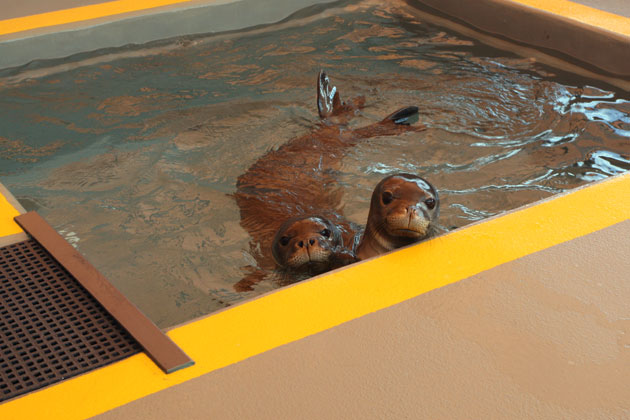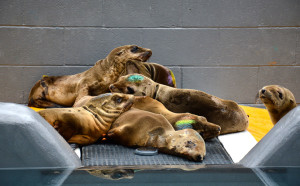t’s early July, and aboard the battleship-like research vessel Hi’ialakai, National Oceanic and Atmospheric Administration (NOAA) scientists are returning from a 26-day search near Midway Island for distressed Hawaiian monk seals. The mission was a success as the ship now transports four underweight juvenile Hawaiian monk seals 1,500 miles to the Big Island for care. The two yearlings, nicknamed Hāla‘I (calm) and Maka‘ala (alert), along with two weaned pups Kūlia (to strive) and Ikaika (strong), would not have survived without help. Fewer than one in five monk seal pups will make it through their first year, according to NOAA.
Waiting to greet the young survivors were researchers from The Marine Mammal Center (TMMC), whose pioneering work on California seals and sea lions during the past four decades has given rise to a collaboration with NOAA in Hawaii. The partnership culminated at the beginning of the month with the grand opening of TMMC’s new $3.2 million Ke Kai Ola Hawaiian Monk Seal Hospital located near Kailua-Kona, on the Big Island, the only facility in the world dedicated to treating and protecting the Hawaiian monk seal.
“We are proud of what we’ve accomplished,” says Jeff Boehm, the center’s executive director. “We are doing nothing short of trying to save a species.”
The young seals became the first patients at Ke Kai Ola, which means, “The Healing Sea.” In addition to its strategic location near a marina and airfield, the 10-seal-capacity facility features well-ventilated pools for both mature animals and juveniles while offering shade, life support systems, water filtration pumps, a laboratory, a food-preparation area and a medical procedure room. It was fully funded by a combination of gifts from individuals and foundations, including donations from the Walnut Creek-based Firedoll Foundation. The lead donor wishes to remain anonymous.
The rescue and rehabilitation partnership comprises the most dedicated monk seal researchers in the world. The hospital will serve as a hub for visiting experts from Europe who likewise seek to protect the Mediterranean monk seal, the only other living species of monk seal, with only 600 individuals remaining. A third member of the family, the Caribbean monk seal, was last spotted in the 1950s and was officially declared extinct by NOAA in 2008 after an extensive five-year search.
“This is a real game-changer,” says Trevor Spradlin, a marine mammal biologist at NOAA’s Office of Protected Resources. “This is why the opening of the hospital is so important. We’ve already lost the Caribbean monk seal species. We’ve only got two left.”

he Hawaiian monk seal gets its name from the short hairs on its head — its skullcap coif — that is said to resemble the do of a religious ascetic. Hawaii’s official state mammal since 2008, the seal is one of the rarest ocean mammals in the world and the only one native to the Hawaiian Islands. The monk seal is also the world’s only tropical pinniped. The population of monk seals, especially juveniles, has diminished over the last several decades due to hunting, overfishing, entanglement in ocean debris, and the rise of predators such as the Galapagos shark. They are now dwindling at a rate of three to four percent each year.
Another Northern Californian ally of the Hawaiian monk seal is UC Santa Cruz biologist Terrie Williams. Williams has studied a pup, nicknamed KP2, in her UCSC lab for over five years and wrote a book about the experience entitled The Odyssey of KP2: An Orphan Seal, a Marine Biologist, and the Fight to Save a Species. Williams, who is currently conducting field research in the Amazon, responded to the news of the opening in an email from the field.
“The new hospital is a wonderful step in the right direction by helping to rescue animals that would otherwise die (every individual monk seal counts at this point), allowing us access to animals to learn about their biology, and providing outreach opportunities for involving local people,” she wrote. “That said, this is a proactive approach to help a species BEFORE it becomes impossible to bring it back from the brink of extinction. The more we all know in terms of the need of wild animals and how humans are impacting them, the more effective our conservation plans and management directions will be.”
This highlights another aspect of the conservation effort: education. According to NOAA’s Spradlin, there are two distinct populations of Hawaiian monk seals, those in the Northwestern Islands and those in the inhabited islands. While the population of roughly 900 seals in the remote archipelago is declining, the approximately 200 that reside on the main chain seem to be holding steady and even growing in numbers thanks to conservation efforts. This, however, has led to more direct run-ins between the mammal and humans.
“Sadly,” Spradlin says, “We’ve had people hurting the seal.”
A New York Times article last May detailed a string of mysterious murders of the animal perpetrated by humans. Thousands of dollars in rewards were offered for tips that could lead to an arrest, but the beatings and shootings continued.
On the flip side, when a monk seal pulls up to a beach populated with humans, an emergency response team will cordon off the animal with tape, a site that ironically draws tourists near the basking animal, though not close enough to touch it. But with the new hospital, volunteer partners on the ground can contact NOAA seal teams for quick-response air or sea transportation to Ke Kai Ola’s world-class facilities. In the battle to save the species, these small victories could signal a turning of the tide.
Long-term rescue numbers also show promise. According to NOAA statistics, up to 30 percent of Hawaiian monk seals are alive because of recovery projects over the years.
“That tells us our efforts have been working,” Spradlin said. “Hopefully, [Ke Kai Ola] will make that 30 percent even greater. We are looking at this as a long-term goal.”
As for the hospital’s first patients—Hāla‘I, Maka‘ala , Kūlia, and Ikaika—their stay at Ke Kai Ola came to an end in late August. Their rehabilitation complete, they were transferred to a NOAA ship, which transported them 1,500 miles back to their homes for a second chance at life. On August 31, with their bellies full and bodies nourished back to health, they were released back into a world of no guarantees.
Ted Andersen is a reporter at the UC Berkeley Graduate School of Journalism. This story was produced as part of a J-school class focusing of environmental issues in the Bay Area.





